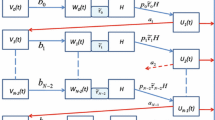Abstract
A deterministic differential equation model for the population dynamics of the human malaria vector is derived and studied. Conditions for the existence and stability of a non-zero steady state vector population density are derived. These reveal that a threshold parameter, the vectorial basic reproduction number, exist and the vector can established itself in the community if and only if this parameter exceeds unity. When a non-zero steady state population density exists, it can be stable but it can also be driven to instability via a Hopf Bifurcation to periodic solutions, as a parameter is varied in parameter space. By considering a special case, an asymptotic perturbation analysis is used to derive the amplitude of the oscillating solutions for the full non-linear system. The present modelling exercise and results show that it is possible to study the population dynamics of disease vectors, and hence oscillatory behaviour as it is often observed in most indirectly transmitted infectious diseases of humans, without recourse to external seasonal forcing.
Similar content being viewed by others
References
Castañera, M.B., Aparicio, J.P., Gurtler, R.E., 2003. A stage-structured stochastic model of the population dynamics of Triatoma infestans, main vector of Chagas disease. Ecol.Model. 162, 33–53.
Cook, K., van den Driessche, P., Zou, X., 1999. Interaction of maturation delay and nonlinear birth in population and epidemic models. J. Math. Biol. 39, 332–352.
Costantino, R.F., Desharnais, R.A., Cushing, J.M., Brian, D. 1998. Chaotic dynamics in an insect population. Science 275(5298), 389–391.
Giles, H.M., Warrel, D.A., 1993. Bruce-Chwatt's Essential Malariology, 3rd edition. Heinemann Medical Books, Portsmouth, NH.
Guckenheimer, J., Holmes, P., 1983. Nonlinear Oscillations, Dynamical Systems, and Bifurcation of Vector Fields. Springer Verlag, New York.
Hassard, B.D., Kazarinoff, N.D., Wan, Y.N., 1981. Theory and Application of Hopf Bifurcations. Cambridge University Press, Cambridge.
Hastings, I.M., D'Alessandro, U., 2000. Modelling a predictable disaster: The rise and spread of drug-resistant malaria. Parasitol. Today 16, 340–347.
Hethcote, W.H., van den Driessche, P., 2000. Two SIS epidemiologic models with delays. J. Math. Biol. 40, 3–26.
Jae, C., Bernard, J.C., 1997. The Evolution of Mating Systems in Insects and Arachnids. Cambridge University Press, Cambridge.
Marsden, J.E., McCracken, M.F., 1976. The Hopf Bifurcation and its Applications. Springer Verlag, New York.
Martens, P., Kovats, R.S., Nijhof, S., de Vries, P., Levermore, M.T.J., Bradley, D.J., Cox, J., McMichael, A.J., 1999. Climate change and future populations at risk of malaria. Global Environ. Change 9, S89–S107.
McCall, P.J., David, W.K., 2002. Learning and memory in disease vectors. Research Update. Trends Parasitol. 18(10), 429–433.
Moon, E.T., 1976. A statistical model for the dynamics of a mosquito vector (Culex tarsalis) population. Biometric 32(2), 355–368.
Ngwa, G.A., 2004. Modelling the dynamics of endemic malaria in growing populations. Discrete Continuous Dyn. Syst. Ser. B 4(4), 1173–1202.
Ngwa, G.A., Ngonghala, C.N., Sama Wilson, N.B, 2001. A model for endemic malaria with delay and variable populations. J. Cameroon Acad. Sci. 1(3), 168–186.
Ngwa, G.A., Shu, W.S., 2000. A mathematical model for endemic malaria with variable human and mosquito populations. Math. Comp. Model. 32(7–8), 747–763.
Ngwa, G.A., Maini, P.K., 1995. Spatio-temporal patterns in a mechanical model for mesenchymal morphogenesis. J. Math. Biol. 33, 489–520.
Porphyre, T. Bicout, D.J., Sabatier, P., 2005. Modelling the abundance of mosquito vectors versus flooding dynamics. Ecol. Model. 183, 173–181.
Powell, A.J., Logan, J.A., 2005. Insect seasonality: A circle map analysis of the temperature-driven life cycles. Theor. Popul. Biol. 67, 161–179.
Raffy, M., Tran, A., 2005. On the dynamics of flying insects populations controlled by large scale information. Theor. Popul. Biol. 68, 91–104.
Smyth, J.D., 1996. An Introduction to Animal Parasitology. Cambridge University Press, Cambridge.
Takahashi, L.T., Norberto, A.M., Wilson C.F., Jr., Petronio, P., Hyun, M.Y., 2005. Mathematical models for Aedes aegypti dispersal dynamics: Travelling waves by wing and wind. Bull. Math. Biol. 67, 509–528.
The World Health Report, 2005. Online: http://www.who.int/whr/2005/en/.
Yandel, S.B., Hogg, B.D., 1988. Modelling insect natality using splines. Biometrics 44(2), 385–395.
Wrona, F., Dixon, J., 1991. Group size and predation risk: A field analysis of the encounter and dilution effects: Am. Nat. 137(2), 186–201.
Yuval, B., Wekesa, J.W., Washino, R.K., 1993. Effect of body size on swarming behaviour and mating success of male Anopheles freeboni (Diptera: culicidae). J. Insect Behav. 6(3), 333–342.
Author information
Authors and Affiliations
Corresponding author
Rights and permissions
About this article
Cite this article
Ngwa, G.A. On the Population Dynamics of the Malaria Vector. Bull. Math. Biol. 68, 2161–2189 (2006). https://doi.org/10.1007/s11538-006-9104-x
Received:
Accepted:
Published:
Issue Date:
DOI: https://doi.org/10.1007/s11538-006-9104-x




